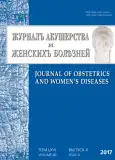Compared diagnostic value of proteinuria definition applying different methods at pregnants with preeclampsia
- Authors: Mozgovaya E.V.1,2, Androsova N.E.1, Dorofeicov V.V.3
-
Affiliations:
- FSBSI “The Research Institute of Obstetrics, Gynecology and Reproductology named after D.O. Ott”
- St. Department of Obstetrics, Gynecology and Reproductology
- Department of Biochemistry Lesgaft National State University of Physical Education, Sport and Health
- Issue: Vol 66, No 4 (2017)
- Pages: 51-56
- Section: Articles
- URL: https://journals.rcsi.science/jowd/article/view/6919
- DOI: https://doi.org/10.17816/JOWD66451-56
- ID: 6919
Cite item
Full Text
Abstract
Colorimetric method of protein determination in urine with use of pyrogallol red (PGR) has certain advantages over a routine method of proteinuria determination with use of sulfosalicylic acid (SSA) which is still applied in most clinics in the Russian Federation. For the purpose to determinate the diagnostic significance of proteinuria estimation by different methods at pregnants with preeclampsia, conducted a comparative research of proteinuria levels at 68 pregnants with preeclampsia and at 15 healthy pregnant by two methods: with sulfosalicylic acid and with pyrogallol red. At the same patients the diagnostic significance of protein/creatinine ratio was evaluated when using the method with PGR. It was revealed that proteinuria determination with PGR- method had authentically higher sensitivity, and proteinuria indices when using this method corresponds to the criteria for evaluation of preeclampsia severity specified in the Ministry of Health Russian Federation Order No. 572n 2012 and the Clinical Recomandations “Hypertensia during pregnancy. Preeclampsia. Eclampsia” (2012). In case of proteinuria determination by method with SSK it is necessary to consider lower sensitivity of the method and adhere to earlier classification of preeclampsia (gestosis) where proteinuria more 1 g/l was regarded as the symptom of severe preeclampsia. Confirmation of the diagnostic significance of protein/creatinine ratio needs further researches.
Keywords
Full Text
##article.viewOnOriginalSite##About the authors
Elena V. Mozgovaya
FSBSI “The Research Institute of Obstetrics, Gynecology and Reproductology named after D.O. Ott”; St. Department of Obstetrics, Gynecology and Reproductology
Author for correspondence.
Email: elmozg@mail.ru
doctor of Medical Sciences, leading scientific researcher, the head 3th department of pathology of pregnancy
Russian Federation, 3, Mendeleevskaya line, Saint Petersburg, 199034; Saint PetersburgNatalya E. Androsova
FSBSI “The Research Institute of Obstetrics, Gynecology and Reproductology named after D.O. Ott”
Email: iagmail@ott.ru
chief of clinical laboratory
Russian Federation, 3, Mendeleevskaya line, Saint Petersburg, 199034Vladimir V. Dorofeicov
Department of Biochemistry Lesgaft National State University of Physical Education, Sport and Health
Email: vdorofeykov@yandex.ru
head of biochemistry department
Russian Federation, Saint PetersburgReferences
- Пупкова В.И., Прасолова Л.М. Определение белка в моче и спинномозговой жидкости: информационно-методическое пособие. – Кольцово, 2005. – 43 с. [Pupkova VI, Prasolova LM. Opredelenie belka v moche i spinnomozgovoj zhidkosti: informacionno-metodicheskoe posobie. Kol’covo; 2005. 43 p. (In Russ.)]
- Айламазян Э.К., Мозговая Е.В. Гестоз: теория и практика. – М.: МЕДпресс-информ, 2008. [Ajlama zjan JeK, Mozgovaja EV. Gestoz: teorija i praktika. Moscow: MEDpress-inform; 2008. (In Russ.)]
- Козлов А.В., Большакова Г.Д., Зимина В.А., Осташова Д.Г. Подходы к стандартизации анализа мо чи // Terra Medica. Лаб. диагностика. – 2009. – № 1(21). – С. 3–8. [Kozlov AV, Bol’shakova GD, Zimina VA, Ostashova DG. Podhody k standartizacii analiza mochi. Terra Medica. Lab Diagnostika. 2009;1(21):3-8. (In Russ.)]
- Козлов А.В., Ларичева Е.С. Концентрация белка в моче: мифы или реальность // Медицинский алфавит. – 2012. – Т. 3. – № 14. – С. 26–31. [Kozlov AV, Laricheva ES. Koncentracija belka v moche: mify ili real’nost’. Medicinskij alfavit. 2012;3(14):26-31. (In Russ.)]
- Johnson AM, Rohlfs EM, Tietz SL. Fundamentals of Clinical Chemistry. 5th edition. Philadelphia: W.B Saunders Company; 2001.
- Ларичева Е.С., Андреев Ю.Н., Ребякова Е.Н., Коз лов А.В. Способен ли метод определения белка в моче пирогаллоловым красным претендовать на роль основного? // Terra Medica. Лаб. диагностика. – 2009. – № 1(21). – С. 24–31. [Laricheva ES, Andre ev JuN, Rebjakova EN, Kozlov AV. Sposoben li metod opredelenija belka v moche pirogallolovym krasnym pretendovat’ na rol’ osnovnogo? Terra Medica. Lab Diagnostika. 2009;1(21):24-31. (In Russ.)]
- Dilena BA, Penberthy LA, Fraser CG. Six methods for determining urinary protein compared. Clin Chem. 1983;29:553-57.
- Yalamati P, Karra ML, Bhongir AV. Comparison of urinary total proteins by four different methods. Am J Obstet Gynecol. 1995Oct;173(4):1111-4.
- Трифонова А.Н. Клинико-лабораторная оценка протеинурии и специфических белков в моче беременных: Автореф. дис. … канд. мед. наук. – СПб., 2015. [Trifonova AN. Kliniko-laboratornaja ocenka proteinurii i specificheskih belkov v moche beremennyh. [dissertation] Saint Petersburg; 2015. (In Russ.)]
- Сухих Г.Т., Вартапетова Н.В., и др. Гипертензия во время беременности. Преэклампсия. Эклампсия. Клинический протокол ФГБУ «Научный центр акушерства, гинекологии и перинатологии им. В.И. Кулакова» МЗ РФ. 2012. [Suhih GT, Vartapetova NV, et al. Gipertenzija vo vremja beremennosti. Prejeklampsija. Jeklampsija. Klinicheskij protokol FGBU “Nauchnyj centr akusherstva, ginekologii i perinatologii im. V.I. Kulakova” MZ RF. 2012. (In Russ.)]
- Haghighi L, Nasiri N, Ebrahimi A, et al. Predictive value of 4-, 8-, and 12-h urine protein and protein-to-creatinine ratio for detection of preeclampsia. Int J Gynaecol Obstet. 2016;134(1):62-5. doi: 10.1016/j.ijgo. 2015.11.023.
- Bhide A, Rana R, Dhavilkar M, et al. The value of the urinary protein:creatinine ratio for the detection of significant proteinuria in women with suspected preeclampsia. Acta Obstet Gynecol Scand. 2015;94(5):542-6. doi: 10.1111/aogs.
- Айламазян Э.К., Репина М.А. Комментарии к клиническому протоколу «Гипертензия во время беременности. Преэклампсия. Эклампсия» // Журнал акушерства и женских болезней. – 2012. – Т. 61. – № 5. – С. 3–9 [Aylamazyan EK, Repina MA. The usual comment to clinical protocol “Hypertension during pregnancy, preeclampsia, eclampsia”. Journal of Obstetrics and Women’s Diseases. 2012;61(5):3-9 (In Russ.)]
- Савельева Г.М., Краснопольский В.И., Стрижаков А.Н., и др. Какой классификации гестозов (пре эклампсии) должен придерживаться врач в повседневной работе? // Российский вестник акушера-гинеколога. – 2013. – № 2. – С. 73–76. [Savel’eva GM, Krasnopol’skii VI, Strizhakov AN, et al. What classification of gestosis (preeclampsia) must a physician adhere to in his/her daily work? Rossiyskiy vestnik akushera-ginekologa. 2013;(2):73-6. (In Russ.)]
Supplementary files







